AMD's Radeon HD 6970 & Radeon HD 6950: Paving The Future For AMD
by Ryan Smith on December 15, 2010 12:01 AM ESTPower, Temperature, & Noise
Last but not least as always is our look at the power consumption, temperatures, and acoustics of the Radeon HD 6900 series. This is an area where AMD has traditionally had an advantage, as their small die strategy leads to less power hungry and cooler products compared to their direct NVIDIA counterparts. However NVIDIA has made some real progress lately with the GTX 570, while Cayman is not a small die anymore.
AMD continues to use a single reference voltage for their cards, so the voltages we see here represent what we’ll see for all reference 6900 series cards. In this case voltage also plays a big part, as PowerTune’s TDP profile is calibrated around a specific voltage.
| Radeon HD 6900 Series Load Voltage | ||||
| Ref 6970 | Ref 6950 | 6970 & 6950 Idle | ||
| 1.175v | 1.100v | 0.900v | ||
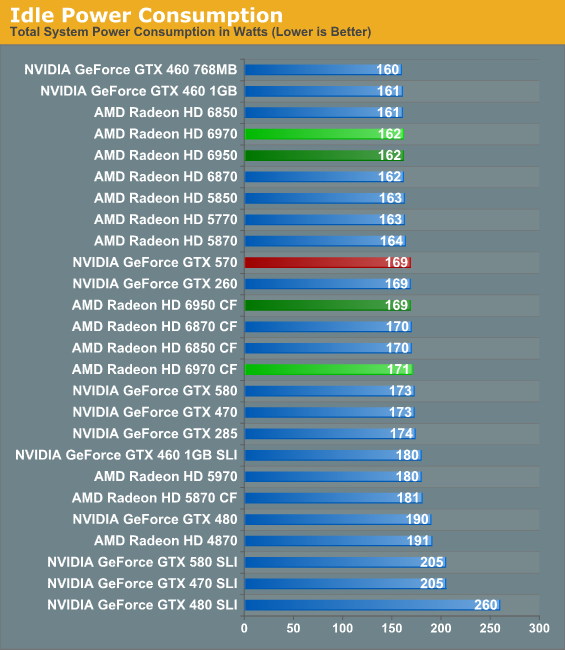
As we discussed at the start of our look at these cards, AMD has been tweaking their designs to take advantage of TSMC’s more mature 40nm process. As a result they’ve been able to bring down idle power usage slightly, even though Cayman is a larger chip than Cypress. For this reason the 6970 and 6950 both can be found at the top of our charts, running into the efficiency limits of our 1200W PSU.
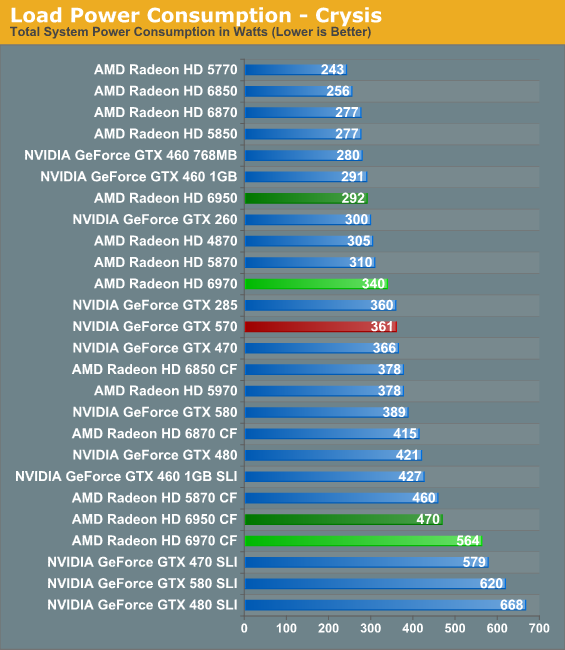
Under Crysis PowerTune is not a significant factor, as Crysis does not generate enough of a load to trigger it. Accordingly our results are rather straightforward, with the larger, more power hungry 6970 drawing around 30W more than the 5870. The 6950 meanwhile is rated 50W lower and draws almost 50W less on the dot. At 292W it’s 15W more than the 5850, or effectively tied with the GTX 460 1GB.
Between Cayman’s larger die and NVIDIA’s own improvements in power consumption, the 6970 doesn’t end up being very impressive here. True, it does draw 20W less, but with the 5000 series AMD’s higher power efficiency was much more pronounced.
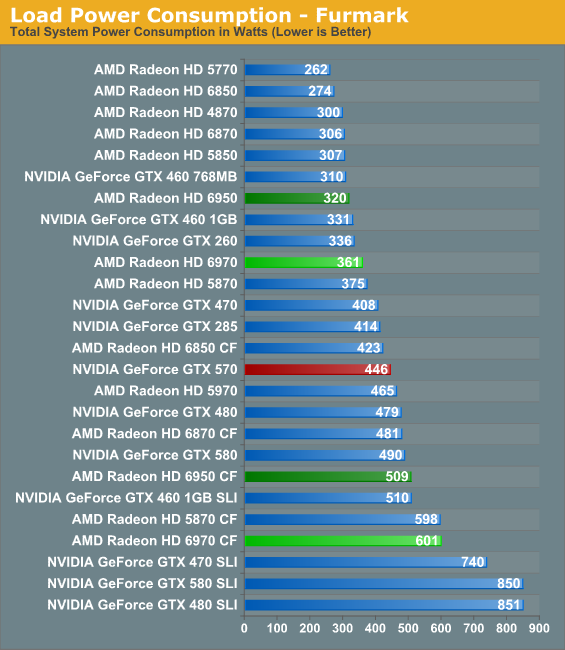
It’s under FurMark that we finally see the complete ramifications of AMD’s PowerTune technology. The 6970, even with a TDP over 60W above the 5870, still ends up drawing less power than the 5870 due to PowerTune throttling. This puts our FurMark results at odds with our Crysis results which showed an increase in power usage, but as we’ve already covered PowerTune tightly clamps power usage to AMD’s TDP, keeping the 6900 series’ worst case scenario for power consumption far below the 5870. While we could increase the TDP to 300W we have no practical reason to, as even with PowerTune FurMark still accurately represents the worst case scenario for a 6900 series GPU.
Meanwhile at 320W the 6950 ends up drawing more power than its counterpart the 5850, but not by much. It’s CrossFire variant meanwhile is drawing 509W,only 19W over a single GTX 580, driving home the point that PowerTune significantly reduces power usage for high load programs such as FurMark.
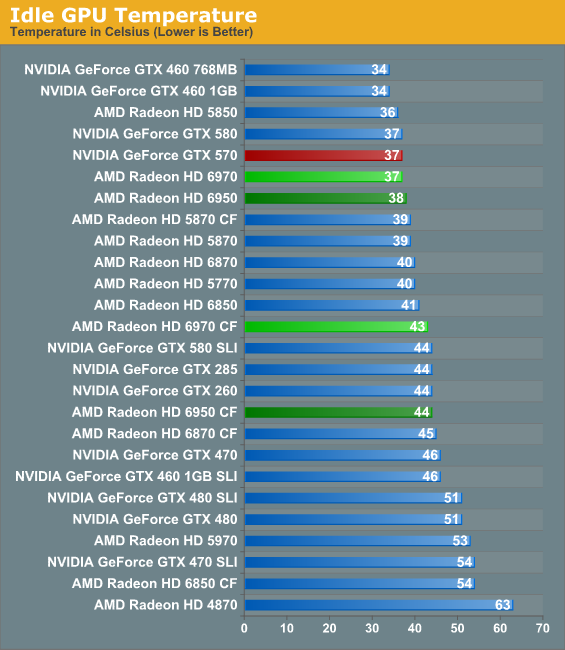
At idle the 6900 series is in good company with a number of other lower power and well-built GPUs. 37-38C is typical for these cards solo, meanwhile our CrossFire numbers conveniently point out the fact that the 6900 series doesn’t do particularly well when its cards are stacked right next to each other.
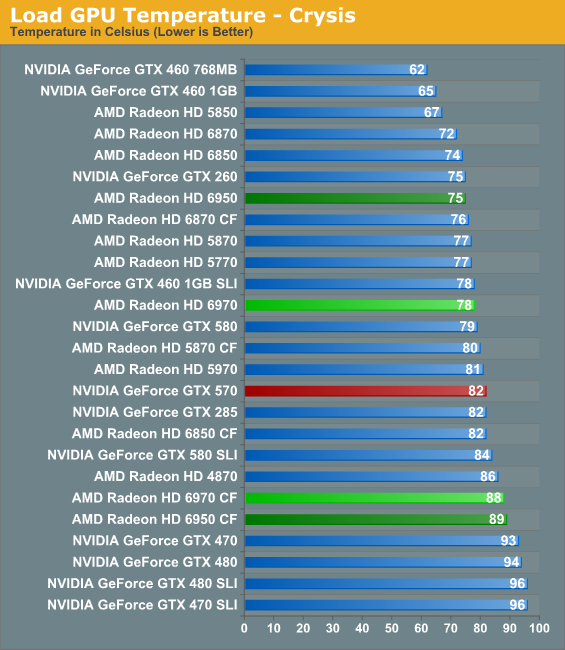
When it comes to Crysis our 6900 series cards end up performing very similarly to our 5800 series cards, a tradeoff between the better vapor chamber cooler and the higher average power consumption when gaming. Ultimately it’s going to be noise that ties all of this together, but there’s certainly nothing objectionable about temperatures in the mid-to-upper 70s. Meanwhile our 6900 series CF cards approach the upper 80s, significantly worse than our 5800 series CF cards.
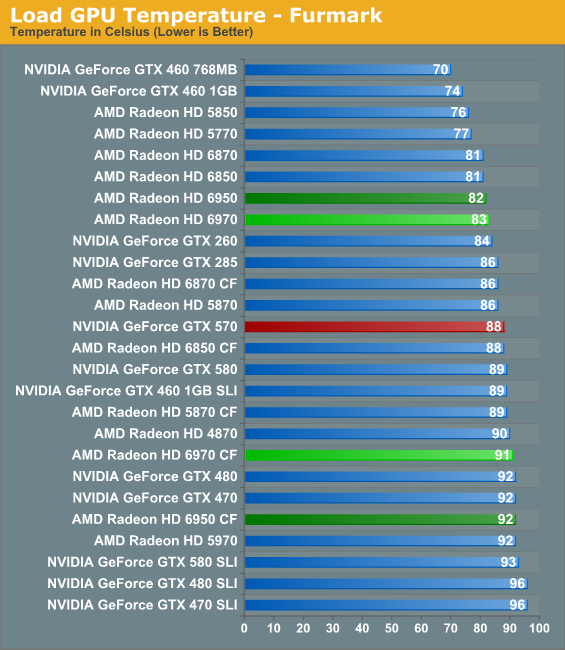
Faced once more with FurMark, we see the ramifications of PowerTune in action. For the 6970 this means a temperature of 83C, a few degrees better than the 5870 and 5C better than the GTX 570. Meanwhile the 6950 is at 82C in spite of the fact that it uses a similar cooler in a lower powered configuration; it’s not as amazing as the 5850, but it’s still quite reasonable.
The CF cards on the other hand are up to 91C and 92C despite the fact that PowerTune is active. This is within the cards’ thermal range, but we’re ready to blame the cards’ boxy design for the poor CF cooling performance. You really, really want to separate these cards if you can.
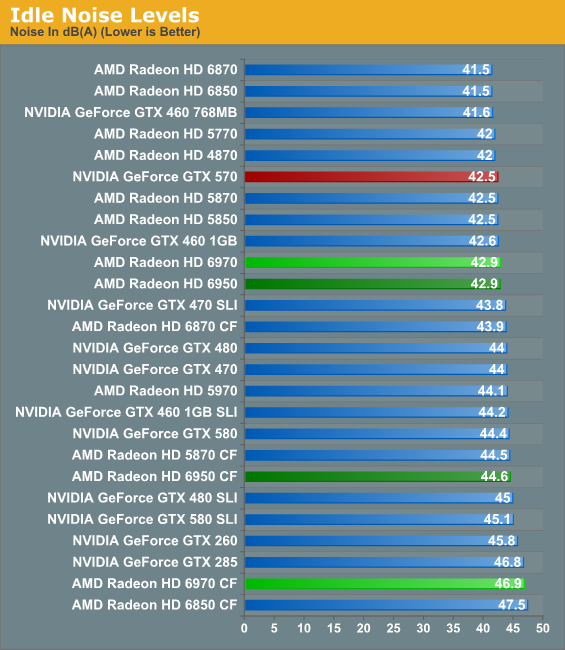
At idle both the 6970 and 6950 are on the verge of running in to our noise floor. With today’s idle power techniques there’s no reason a card needs to have high idle power usage, or the louder fan that often leads to.

Last but not least we have our look at load noise. Both cards end up doing quite well here, once more thanks to PowerTune. As is the case with power consumption, we’re looking at a true worst case scenario for noise, and both cards do very well. At 50.5db and 54.6db neither card is whisper quiet, but for the gaming performance they provide it’s a very good tradeoff and quieter than a number of slower cards. As for our CrossFire cards, the poor ventilation pours over in to our noise tests. Once more, if you can separate your cards you should do so for greatly improved temperature and noise performance.










168 Comments
View All Comments
MeanBruce - Wednesday, December 15, 2010 - link
TechPowerUp.com shows the 6850 as 95percent or almost double the performance of the 4850 and 100percent more efficient than the 4850@1920x1200. I also am upgrading an old 4850, as far as the 6950 check their charts when they come up later today.mapesdhs - Monday, December 20, 2010 - link
Today I will have completed by benchmark pages comparing 4890, 8800GT and
GTX 460 1GB (800 and 850 core speeds), in both single and CF/SLI, for a range
of tests. You should be able to extrapolate between known 4850/4890 differences,
the data I've accumulated, and known GTX 460 vs. 68xx/69xx differences (baring
in mind I'm testing with 460s with much higher core clocks than the 675 reference
speed used in this article). Email me at mapesdhs@yahoo.com and I'll send you
the URL once the data is up. I'm testing with 3DMark06, Unigine (Heaven, Tropics
and Sanctuary), X3TC, Stalker COP, Cinebench, Viewperf and PT Boats. Later
I'll also test with Vantage, 3DMark11 and AvP.
Ian.
ZoSo - Wednesday, December 15, 2010 - link
Helluva 'Bang for the Buck' that's for sure! Currently I'm running a 5850, but I have been toying with the idea of SLI or CF. For a $300 difference, CF is the way to go at this point.I'm in no rush, I'm going to wait at least a month or two before I pull any triggers ;)
RaistlinZ - Wednesday, December 15, 2010 - link
I'm a bit underwhelmed from a performance standpoint. I see nothing that will make me want to upgrade from my trusty 5870.I would like to see a 2x6950 vs 2x570 comparison though.
fausto412 - Wednesday, December 15, 2010 - link
exactly my feelings.it's like thinking Miss Universe is about to screw you and then you find out it's her mom....who's probably still hot...but def not miss universe
Paladin1211 - Wednesday, December 15, 2010 - link
CF scaling is truly amazing now, I'm glad that nVidia has something to catch up in terms of driver. Meanwhile, the ATI wrong refresh rate is not fixed, it stucks at 60hz where the monitor can do 75hz. "Refresh force", "refresh lock", "ATI refresh fix", disable /enable EDID, manually set monitor attributes in CCC, EDID hack... nothing works. Even the "HUGE" 10.12 driver can't get my friend's old Samsung SyncMaster 920NW to work at its native 1440x900@75hz, both in XP 32bit and win 7 64bit. My next monitor will be an 120hz for sure, and I don't want to risk and ruin my investment, AMD.mapesdhs - Monday, December 20, 2010 - link
I'm not sure if this will help fix the refresh issue (I do the following to fix max res
limits), but try downloading the drivers for the monitor but modify the data file
before installing them. Check to ensure it has the correct genuine max res and/or
max refresh.
I've been using various models of CRT which have the same Sony tube that can
do 2048 x 1536, but every single vendor that sells models based on this tube has
drivers that limited the max res to 1800x1440 by default, so I edit the file to enable
2048 x 1536 and then it works fine, eg. HP P1130.
Bit daft that drivers for a monitor do not by default allow one to exploit the monitor
to its maximum potential.
Anyway, good luck!!
Ian.
techworm - Wednesday, December 15, 2010 - link
future DX11 games will stress GPU and video RAM incrementally and it is then that 6970 will shine so it's obvious that 6970 is a better and more future proof purchase than GTX570 that will be frame buffer limited in near future gamesNickel020 - Wednesday, December 15, 2010 - link
In the table about whether PowerTune affects an application or not there's a yes for 3DMark, and in the text you mention two applications saw throttling (with 3DMark it would be three). Is this an error?Also, you should maybe include that you're measuring the whole system power in the PowerTune tables, it might be confusing for people who don't read your reviews very often to see that the power draw you measured is way higher than the PowerTune level.
Reading the rest now :)
stangflyer - Wednesday, December 15, 2010 - link
Sold my 5970 waiting for 6990. With my 5970 playing games at 5040x1050 I would always have a 4th extended monitor hooked up to a tritton uve-150 usb to vga adapter. This would let me game while having the fourth monitor display my teamspeak, afterburner, and various other things.Question is this!! Can i use the new 6950/6970 and use triple monitor and also use a 4th screen extended at the same time? I have 3 matching dell native display port monitors and a fourth with vga/dvi. Can I use the 2 dp's and the 2 dvi's on the 6970 at the same time? I have been looking for this answer for hours and can't find it! Thanks for the help.